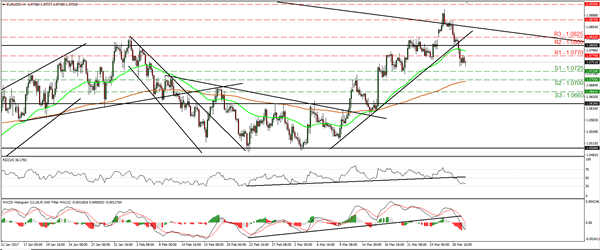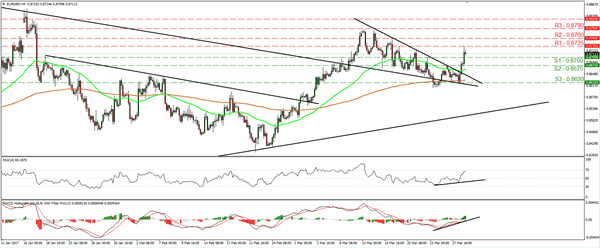The euro came under selling pressure yesterday, following a Reuters report that investors over-interpreted the signals from the ECB’s March policy meeting. The report revealed that ECB officials only wanted to communicate reduced risks and not a step towards a reduction in stimulus. In addition, it was noted that policymakers are now cautious of making any new changes to the April statement, and that they are worried of a potential surge in the bloc’s government bond yields.
During the European morning Wednesday, EUR/USD was trading near the key zone of 1.0800 and the uptrend line drawn from the low of the 9th of March. Nevertheless, the signals this report sent to market participants pushed the rate below that key support crossroad, which in our view shifts the short-term outlook of the pair to neutral for now. The rate could continue lower for a while given this change in sentiment towards the ECB plans and is possible to aim for the 1.0725 (S1) support soon. A clear break below that level could target the next one of 1.0700 (S2). However, we think it’s too early to assume that the outlook has turned back bearish.
Yesterday’s report suggests that the ECB is unlikely to change its language in April, especially considering that the meeting will take place ahead of the French election, a political event that could add a risk premium to European bond yields. Something like that could enhance the concerns of ECB policymakers with regards to a surge in yields and therefore, we expect the ECB to maintain a balanced tone, at least until the outcome of the election is sealed. For the next couple of months, EUR-traders may shift their attention to headlines regarding the French vote.
UK vs EU: Let the negotiations begin
Yesterday, the EU officially received the UK’s Article 50 letter, which marks the beginning of two years of negotiations, the guidelines of which will be published by the EU within the next couple of days. These guidelines are expected to focus on the ‘divorce bill’ first. The EU wants the UK to cover the budget commitments they agreed to, which amount to EUR 63 billion. This bill seems to face high criticism from the UK government. The UK Trade Secretary previously described the notion of being charged for leaving the EU as ‘absurd’.
As for the pound, it didn’t react much on the triggering given that the event and the timing were known and expected. Nevertheless, we expect the ‘divorce bill’ to attract market attention. In our opinion, signals that the UK will not pay this bill could weigh on sterling, as something like that could lead to delays in the rest of the negotiating process. Considering that the UK has two years to negotiate its exit deal, we think that potential delays may be viewed as more negative for Britain than the EU. Overall though, we believe that the financial world may focus primarily on the subject of trade. So, in our view, the pound’s broader path could depend on that to a large extend.
GBP/JPY was one of the sterling crosses to trade higher in the aftermath of the triggering. The pair rebounded from 137.50 (S2) to find resistance slightly below 138.80 (R1). The price structure on the 4-hour chart still suggests a short-term downtrend and as such, we would expect the bears to make a comeback soon. A dip back below 138.30 (S1) could confirm that and perhaps pave the way for another test near 137.50 (S2).
As for today’s highlights:
Germany’s preliminary CPI for March is due out, just one day ahead of Eurozone’s print. The forecast is for the nation’s CPI to have slowed to +1.9% yoy from +2.2% yoy previously, which could increase speculation for the bloc’s rate to move in a similar fashion. Although something like that may cause the euro to trade a bit lower, we doubt that it will be particularly worrisome for ECB policymakers, given that they made it clear they pay more attention to core CPI prints.
In the US, the final estimate of Q4 2016 is due out, but considering that the 1st quarter of 2017 is almost over, we will treat these data as outdated. Initial jobless claims for the week ended March 24th are also out.
As for the speakers, we have three on the agenda: New York Fed President William Dudley, Dallas Fed President Robert Kaplan and ECB Executive Board member Yves Mersch.
EUR/USD

Support: 1.0725 (S1), 1.0700 (S2), 1.0665 (S3)
Resistance: 1.0770 (R1), 1.0800 (R2), 1.0825 (R3)
GBP/JPY

Support: 138.30 (S1), 137.50 (S2), 137.00 (S3)
Resistance: 138.80 (R1), 139.40 (R2), 140.40 (R3)













